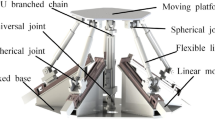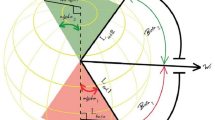Abstract
For analyzing natural frequency of a 3SPS+1PS parallel hip joint manipulator, a rigid-flexible coupling theory is proposed. 3SPS denotes that the PHJM has three legs and each leg type is SPS. 1PS denotes that the PHJM has one constrained leg and the constrained leg type is PS. The rigid finite element method and flexible finite element method are the base of the rigid-flexible coupling theory. Firstly, the basic element models of the PHJM are established based on the rigid-flexible coupling analysis. Secondly, the elastic dynamic models of the flexible legs are established based on the Lagrange equation and flexible finite method. Finally, the rigid-flexible coupling model of the PHJM is assembled by building the relationship between the rigid and flexible elements. Based on the rigid-flexible model, the natural frequency of the PHJM is analyzed. In addition, the effect parameters of the natural frequency are analyzed. The analysis results of the natural frequency show that the natural frequency is symmetric distribution in the working space, and the minimum value of the 1st order natural frequency is 2.3 Hz. The operating frequency (1 Hz) is much lower than the 1st order natural frequency, so the PHJM will not generate resonance and can operate stably. The analysis results of the parameter show that the PHJM has the minimal sensitivity with the effect parameter E and has the maximal sensitivity with the effect parameter H, so the length of the middle leg has the biggest impact on the natural frequency. Natural frequency analysis results have been checked by the hammer test, which verifies the feasibility of the rigid-flexible coupling theory. At the same time, the regression analysis is carried out based on the hammer test results. Using the rigid-flexible coupling theory to solve the natural frequency of the parallel manipulator, the physical meaning is explicit and the modeling process is clear, so the rigid-flexible coupling theory is a universal method.
Similar content being viewed by others
References
S. T. Wang, G. Cheng and D. H. Yang, Unified kinematics analysis and low-velocity driving optimization for parallel hip joint manipulator, ASME Journal of Mechanical Design, 137 (8) (2015) 1–11.
G. Cheng, S. T. Wang and D. H. Yang, Finite element method for kinematic analysis of parallel hip joint manipulator, ASME Journal of Mechanisms and Robotics, 7 (4) (2015) 1–10.
G. Cheng, Y. Li and L. L. Feng, Configuration bifurcation and self-motion analysis of 3SPS + 1PS bionic parallel test platform for hip joint simulator, Mechanism and Machine Theory, 86 (2015) 62–72.
G. Cheng, J. L. Yu and W. Gu, Kinematic analysis of 3SPS+1PS bionic parallel test platform for hip joint simulator based on unit quaternion, Robotics and Computer- Integrated Manufacturing, 28 (2) (2012) 257–264.
Y. Q. Yu, Z. C. Du and J. X. Yang, An experimental study on the dynamics of a 3-RRR flexible parallel robot, IEEE Transaction on Robotics, 27 (5) (2011) 992–997.
Z. C. Du, Y. Q. Yu and L. Y. Su, Sensitivity analysis for dynamic characteristic of flexible parallel robots, IEEE International Conference on Robotics and Biomimetics (2006) 1151–1156.
X. P. Zhang, J. K. Mills and W. L. Cleghorn, Dynamic modeling and experimental validation of a 3-PRR parallel manipulator with flexible intermediate link, Journal of Intelligent & Robotic Systems, 50 (4) (2007) 323–340.
K. D. Santosha and E. Peter, Dynamic analysis of flexible manipulators, a literature review, Mechanism and Machine Theory, 41 (7) (2006) 749–777.
D. Zhang, Z. Gao and X. P. Su, A comparison study of three degrees of freedom parallel robotic machine tools with/without actuation redundancy, International Journal of Computer Integrated Manufacturing, 25 (3) (2012) 230–247.
Z. C. Du and Y. Q. Yu, Research on dynamic stress and endurance characteristics of flexible robots, China Mechanical Engineering, 18 (24) (2007) 2985–2989.
H. H. Li, Z. Y. Yang and T. Huang, Dynamics and elasto dynamics optimization of a 2-DOF planar parallel pick-andplace robot with flexible links, Structural and Multidisciplinary Optimization, 38 (2) (2009) 195–204.
Y. M. Li and S. Staicu, Inverse dynamics of a 3-PRC parallel kinematic machine, Nonlinear Dynamics, 67 (2) (2012) 1031–1041.
C. F. Yang and J. W. Han, Dynamic coupling analysis of a spatial 6-DOF electro-hydraulic parallel manipulator using a modal decoupling method, International Journal of Advanced Robotic Systems, 10 (104) (2013) 1–8.
B. Kang and J. K. Mills, Dynamic modeling of structurallyflexible planar parallel manipulator, Robotica, 20 (3) (2002) 329–339.
G. Piras, W. L. Cleghorn and J. K. Mills, Dynamic finiteelement analysis of a planar high-speed, high-precision parallel manipulator with flexible links, Mechanism and Machine Theory, 40 (7) (2005) 849–862.
B. Nicolas, C. Stéphane and W. Philippe, Sensitivity comparison of planar parallel manipulators, Mechanism and Machine Theory, 45 (11) (2010) 1477–1490.
X. L. Chen, S. S. Jia and D. Yu, Research on dynamic behaviors for a parallel machine tool considering elastic component, Mechanics and Materials, 26 (8) (2011) 512–516.
X. L. Chen, W. B. Li and D. Yu, Analysis of stress and natural frequencies of high-speed spatial parallel mechanism, Journal of Central South University, 20 (10) (2013) 2676–2684.
M. Yu, J. Zhao and L. Zhang, Study on the dynamic characteristics of a virtual-axis hybrid polishing machine tool by flexible multibody dynamics, Journal of Engineering Manufacture, 218 (9) (2004) 1067–1076.
K. Miller, Optimal design and modeling of spatial parallel manipulators, The International Journal of Robotics Research, 23 (2004) 127–140.
S. Z. Liu, Y. Q. Yu and Z. C. Zhu, Dynamic modeling and analysis of 3-RRS parallel manipulator with flexible links, Journal of Central South University of Technology, 17 (2) (2010) 323–331.
Q. H. Zhang, X. M. Zhang and J. L. Liang, Dynamic analysis of planar 3-RRR flexible parallel robot, IEEE International Conference on Robotics and Biomimetics (2012) 154–159.
Y. J. Zhao, F. Gao and X. J. Dong, Dynamics analysis and characteristics of the 8-PSS flexible redundant parallel manipulator, Robotics and Computer-Integrated Manufacturing, 7 (5) (2011) 918–928.
H. H. Li, Z. Y. Yang and J. P. Mei, A new dynamic index of parallel robots with flexible links, IEEE International Conference on Industrial Technology (2008) 5–10.
P. Mukherjee, B. Dasgupta and A. K. Mallik, Dynamic stability index and vibration analysis of a flexible Stewart platform, Journal of Sound and Vibration, 307 (3) (2007) 495–512.
Author information
Authors and Affiliations
Corresponding author
Additional information
Recommended by Associate Editor Kyoungchul Kong
Songtao Wang received the B.E. degree in School of Mechatronic Engineering in 2009 from China University of Mining and Technology, Xuzhou, China and the Ph.D. degree in School of Mechatronic Engineering in 2015 from China University of Mining and Technology, Xuzhou, China. He is currently postdoctoral researching in School of Information Science and Technology, Tsinghua University, Beijing, China. His research interests include parallel manipulator system, active vibration control, and stability control analysis.
Gang Cheng received the M.S. degree in 2003 from the Chinese Academy of Sciences and the Dr. Sc. Tech. degree in 2008 from China University of Mining and Technology. Currently, he is a Professor of China University of Mining and Technology in China. His research interests include mechanism theory and reliability of electromechanical equipment.
Xihui Chen is currently a doctoral student at the School of Mechatronic Engineering of China University of Mining and Technology in China. His research interest is vibration analysis and fault diagnosis.
Jianhua Yang received the B.E. degree in mechanical engineering from Hebei University of Engineering, Handan, in 2006 and the Ph.D. degree in dynamics and control from Nanjing University of Aeronautics and Astronautics, Nanjing, in 2011. He is currently an Associate Professor in China University of Mining and Technology, Xuzhou. His research interest includes the nonlinear vibration, parallel mechanism. He is the author of more than 30 articles.
Rights and permissions
About this article
Cite this article
Wang, S., Cheng, G., Chen, X. et al. Natural frequency analysis and experiment for 3SPS+1PS parallel hip joint manipulator based on rigid-flexible coupling theory. J Mech Sci Technol 31, 1447–1462 (2017). https://doi.org/10.1007/s12206-017-0245-7
Received:
Revised:
Accepted:
Published:
Issue Date:
DOI: https://doi.org/10.1007/s12206-017-0245-7




